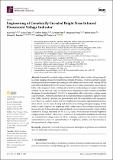Engineering of Genetically Encoded Bright Near-Infrared Fluorescent Voltage Indicator
Author(s)
Xiao, Xian; Yang, Aimei; Zhang, Hanbin; Park, Demian; Wang, Yangdong; Szabo, Balint; Boyden, Edward S.; Piatkevich, Kiryl D.; ... Show more Show less
Downloadijms-26-01442.pdf (2.579Mb)
Publisher with Creative Commons License
Publisher with Creative Commons License
Creative Commons Attribution
Terms of use
Metadata
Show full item recordAbstract
Genetically encoded voltage indicators (GEVIs) allow for the cell-type-specific real-time imaging of neuronal membrane potential dynamics, which is essential to understanding neuronal information processing at both cellular and circuit levels. Among GEVIs, near-infrared-shifted GEVIs offer faster kinetics, better tissue penetration, and compatibility with optogenetic tools, enabling all-optical electrophysiology in complex biological contexts. In our previous work, we employed the directed molecular evolution of microbial rhodopsin Archaerhodopsin-3 (Arch-3) in mammalian cells to develop a voltage sensor called Archon1. Archon1 demonstrated excellent membrane localization, signal-to-noise ratio (SNR), sensitivity, kinetics, and photostability, and full compatibility with optogenetic tools. However, Archon1 suffers from low brightness and requires high illumination intensities, which leads to tissue heating and phototoxicity during prolonged imaging. In this study, we aim to improve the brightness of this voltage sensor. We performed random mutation on a bright Archon derivative and identified a novel variant, monArch, which exhibits satisfactory voltage sensitivity (4~5% ΔF/FAP) and a 9-fold increase in basal brightness compared with Archon1. However, it is hindered by suboptimal membrane localization and compromised voltage sensitivity. These challenges underscore the need for continued optimization to achieve an optimal balance of brightness, stability, and functionality in rhodopsin-based voltage sensors.
Date issued
2025-02-08Department
Massachusetts Institute of Technology. Center for Neurobiological Engineering; Program in Media Arts and Sciences (Massachusetts Institute of Technology); Massachusetts Institute of Technology. Department of Brain and Cognitive SciencesJournal
Department of Brain and Cognitive Sciences
Publisher
Multidisciplinary Digital Publishing Institute
Citation
Xiao, X.; Yang, A.; Zhang, H.; Park, D.; Wang, Y.; Szabo, B.; Boyden, E.S.; Piatkevich, K.D. Engineering of Genetically Encoded Bright Near-Infrared Fluorescent Voltage Indicator. Int. J. Mol. Sci. 2025, 26, 1442.
Version: Final published version